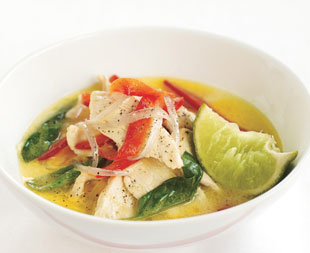This week, for BonAppetit.com's Project Recipe I made a Thai Green Chicken Curry—and it was a huge winner. The only problem, and I hesitate to say it was a problem, is that it was almost too easy.

Over the course of my recipe reviews for BA, I've made it clear that I love shortcuts in the kitchen. Going the long way around does not appeal to me. But in the case of the Thai Green Curry, I actually wished for a little more complication.
This recipe was what I like to refer to as a "mix and serve" and there is nothing wrong with that! Mix and serve recipes are
usually my favorite: stir fries, many pastas, cereal!
I just was hoping to learn how to actually make curry—the blend of spices, the construction of the dish. (I understand that we're talking about Thai rather than Indian curry, which is different.) But this recipe calls for purchased curry paste.
I don't want to sound ridiculous here—I have no intention of ever making my own fish sauce or prying milk out of a coconut (actually, I could
see myself doing that), I just wanted to get a little deeper with this recipe.
So my editor suggested I try the same recipe with a curry made from scratch, and decide which I liked better.
I'm surprised by the results; both curries were very palatable and worth eating once a week so often you tire of them eventually, but the pre-made curry paste actually created a more balanced dish.
I have to say that this was not a perfectly designed experiment—more art than science. The BA Test Kitchen referred me to a curry paste recipe with slightly different ingredients than the jar I had bought at the store (probably because BA recipes have to take into account that not every American lives near a store that sells galangal, Thai ginger). My jar of Thai Kitchen green curry paste contained: green chili, garlic, lemongrass, galangal, salt, shallot, spices, kaffir lime. The BA recipe contained: onion, cilantro, lemongrass, tumeric, ginger, cumin, garlic and red pepper. Sarah Tengalia, the Senior Food Editor, suggested adding more red pepper for heat and a kaffir lime leaf for a "floral note". I did add extra pepper (almost doubling it after the initial taste) but alas, I couldn't find a kaffir lime leaf.
Making my own curry paste was a snap. I measured all the dry spices, cut some garlic, minced cilantro, fresh ginger and lemongrass. It was my first time ever
cooking with lemongrass so I toasted to that (BV Chardonnay on sale). I always love meeting a new ingredient in my own kitchen. Lemongrass is one of my favorite flavors in a dish, good to know I'm capable of using it too. After I made the paste, I used it to carry out the other recipe: heated it
a minute with oil, added the chicken, added coconut milk, a little fish
sauce, let the sauce thicken and then served the whole thing over rice.
My own curry's taste was good, definitely good, but not as floral or fresh as I would have liked. Ironic, I know, considering I used fresh ginger, fresh lemongrass, fresh onion, fresh garlic, and fresh cilantro. There is a chance that the increase in red pepper tramped down the flavors a little bit. I would like to try it again with that kaffir lime leaf and maybe a little extra lemongrass (yes, there might be a round three for me and this recipe).
But the experiment was a success! I set out to see if making a curry was easy and it is, very easy indeed. As it compared to the pre-made curry (indulge me in an athletic metaphor), making your own curry is like going to the gym and using the elliptical machine on slow while you watch Law and Order. Using the purchased curry paste is like going to the gym and just using the sauna. Both are good ideas on a Monday night.
*not directly side by a side, a few days separated them. You have to trust my sense memory on this one.
Bridget Moloney is an actress, writer, and blogger for Bon Appétit.
 More on bonappetit.com:
More on bonappetit.com:
Chicken Recipes
Asian Dishes Slideshow
Curry
Valentine's Day Guide